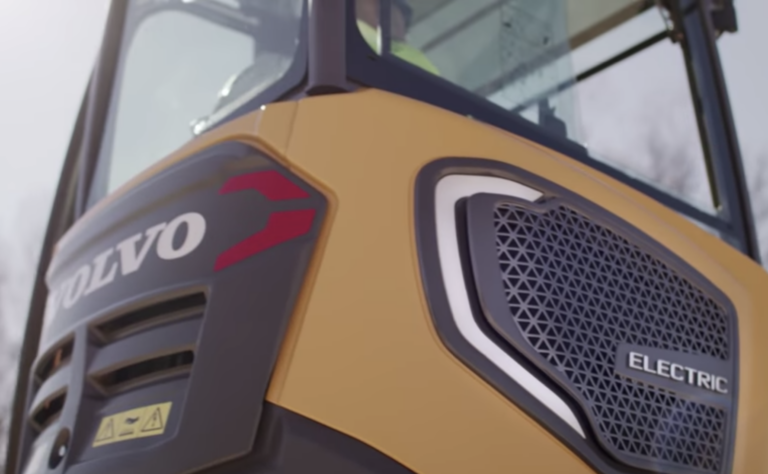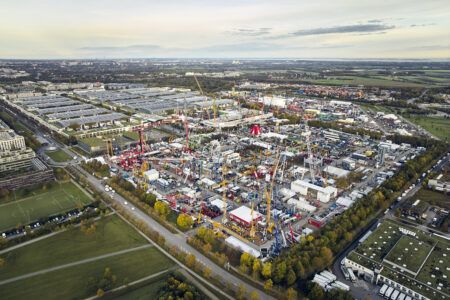Volvo Construction Equipment is the first OEM to commit to going fully electric on two full ranges of compact equipment, with deliveries of the first production machines expected to begin in June 2021.
The first two models were unveiled at Bauma 2019 in Munich, Germany. The electric ECR25 excavator and L25 wheel loader run on lithium-ion batteries and have zero exhaust emissions.
In a unique Q&A, the company addresses questions and concerns surrounding this strategic shift.
Why is Volvo CE making this change?
The world is moving toward a more environmentally conscious, sustainable future — and that includes the construction industry. In fact, fifteen states and the District of Columbia have already pledged to have 100% of all new medium- and heavy-duty truck sales be emissions-free by 2050. There have been many emissions incentives and zero-emissions levels like this set for on-road vehicle improvements, and the off-road industry is preparing to follow suit. As part of the Volvo Group, which includes Volvo Trucks, we’re uniquely positioned to be able to draw upon this collective expertise to bring this technology to the construction industry.
Additionally, we see demand from our customers to meet their own self-set lower emissions goals. Volvo now gives them options to help reach these targets with our mini electric excavators and wheel loaders.
This move positions Volvo CE as the first construction equipment manufacturer to commit to an electric future for its compact machine range — stopping new diesel engine development of mini excavator models globally from the EC15 to EC27 and compact front end loaders from the L20 to L28. That’s a bold decision, made in step with a challenge from our Volvo CE President, Melker Jernberg, to stir the market for zero exhaust emission compact equipment, where we see the most potential for acceptance and application. And while some competitor manufacturers offer electric or hybrid models, none matches Volvo’s level of development commitment and scale of the announced product range. To learn more about these new electric vehicles, check out our electric construction equipment page.
For electric equipment to become the norm, machines need to be designed and proven to overcome the main concerns voiced by skeptical buyers around energy capacity, performance and price. These first battery-electric models are already changing mindsets by bringing our customers along every step in this electromobility journey.
How will these first electric compact machines compare to their traditional equivalent?
The ECR25 mini excavator is fitted with lithium-ion batteries and one electric motor that replaces the diesel engine to power the hydraulics in order to move the machine and attachment. The machine’s batteries store enough electric energy to power the ECR25 for up to eight hours in its most common applications, such as utility work.
The L25 compact wheel loader also uses lithium-ion batteries, which allow for up to eight hours of operation in the machine’s regular applications, including light infrastructure work, gardening, landscaping and agriculture. The L25 loader also incorporates two dedicated electric motors, one for the drivetrain and one for the hydraulics. Decoupling the subsystems has led to higher efficiency in both the systems and the entire machine.
Both the ECR25 and L25 have onboard chargers that enable overnight charging via a 220/240V electrical socket. In addition, an off-board, three-phase fast charger can be used to charge both machines. With the fast-charge options, the ECR25 can be at 80% power within one hour of charge time, and the L25 within two hours of charge time.
The electric versions have performance levels similar to their conventional diesel equivalents so customers will get the same performance in more efficient, environmentally-friendly machines. For example, the ECR25 electric mini excavator has a digging depth of 9 ft (2.76 m) and a breakout force of 4,541 lbf (20.2 kN). The L25 electric front-end loader has a full-turn tipping load of 3.7 tons (3.35 metric tons), a dump height of 8.2 ft (2.5 m) and a 2.2-ton (2-metric ton) payload fork load capacity.
When will they be offered in North America?
The prebooking tool will be made available to customers in the U.S. and Canada, expanding the successful launch earlier in the year to key European markets. By signing up, customers can reserve a place in the production queue. Afterward, they will be alerted if they have been selected to complete an order for the machines. Again, the first deliveries of production machines are expected in June 2021.
Customer pilots, like the grant administered by the South Coast Air Quality Management District in California, will be underway throughout Q4 2020 and into Q1 2021.
These machines are designed for any state or local government fleet that has set or is anticipated to set electric vehicle targets or clean air regulations. They’re also ideal for companies with aggressive sustainability targets and those that need equipment to operate in low-noise or zero-emissions environments.
How will the price compare to their diesel counterparts?
The total cost of ownership (TCO) should be considered when evaluating the actual price of the new electric models, largely around fuel savings, less scheduled maintenance and extended component life. No prices are announced at this time, but even though the electric machines might not be cheaper, they add more value for our customers. They allow them to bid on emission-restricted jobs, work during the night in densely populated areas and work indoors, as well as in many other niche applications unsuitable for conventional diesel machines.
.jpg)
What other electric equipment is Volvo working on?
We’re conducting extensive research and product development on a range of hybrid and battery-electric solutions, some demonstrated in the recent Electric Site project with Skanska, which saw a 98%reduction in carbon emissions. The Electric Site showed that electrification is beneficial, but also possible with different machine types and sizes using different technologies.
It’s clear that our industry is in a period of rapid change. But for many machine sizes, applications and markets, the diesel engine will remain the most appropriate power source for a number of years, and we will continue to manufacture diesel machines of all sizes. So the decision on what you use — diesel powered or electric — rests with you.





